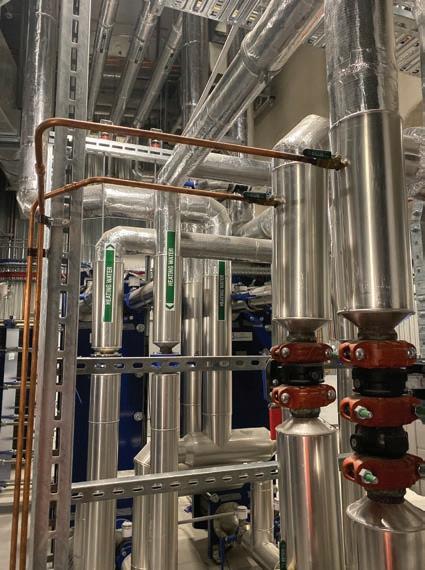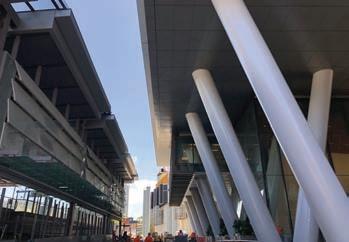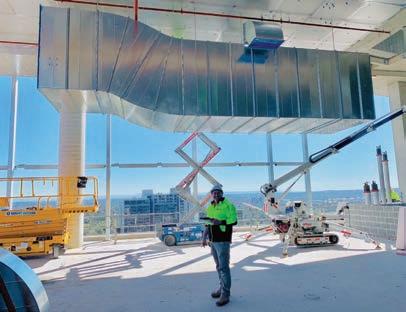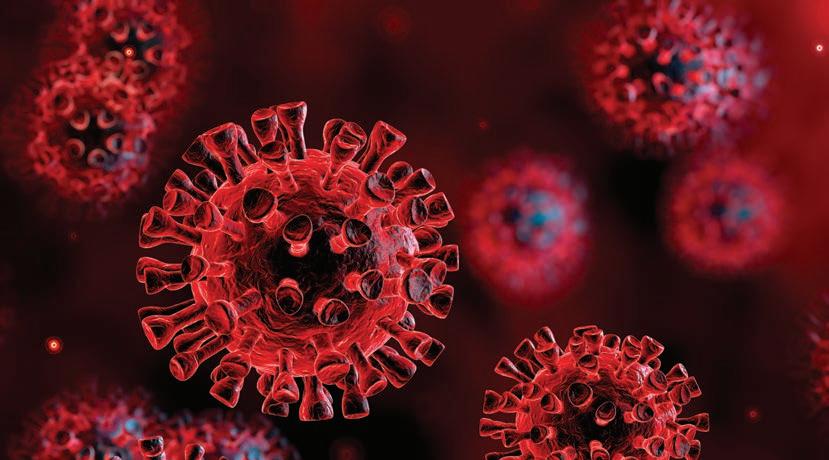
13 minute read
Next big thing
Sean McGowan
Parramatta in Sydney’s west is undergoing a significant transformation as it seeks to become “Australia’s next great city”. Sean McGowan reports on the progress of the new Parramatta Square development, which is re-imagining the city’s centre.
Advertisement
Image courtesy AG Coombs
As the first stage of Walker Corporation’s new $2.4 billion Parramatta Square development – one of the largest urban renewal projects in the country – 4 Parramatta Square is the first commercial office tower to have reached completion at the site.
Designed by architects Johnson Pilton Walker (JPW) and constructed by Built with its joint venture partner, major Japanese construction firm Obayashi Corporation (BOJV), the building offers A-grade office accommodation to house three government agencies in a single building. This arrangement improves efficiency, collaboration and the services provided to the people of New South Wales.
The 65,000m² 34-storey commercial office building features a three level “super basement car park” plus multiple podium levels of vibrant retail and public spaces


that link directly to Parramatta Station and rail links to the Sydney CBD.
A business and events centre also provides high quality office suites and flexible, functional event spaces to cater to the growing needs of tenants.
Master planning
The wider Parramatta Square development has been designed to re-imagine the civic and commercial heart of the city.
Located across a three hectare city block, the precinct will include four Walker-developed commercial office towers to complement the already constructed Western Sydney University (WSW) School of Business, Sydney Water Headquarters and 6,000m² of public space.
It will also feature a new state-of-the-art civic building to accommodate the City of Parramatta council and public library (5 Parramatta Square), while the existing heritagelisted Town Hall will be refurbished to meet BCA upgrade requirements.
The new civic, cultural and community building – dubbed by the local Mayor as the “beating heart of Parramatta” - will be the final addition to Parramatta Square and feature a wave-shaped façade of crystalline blocks as well as rooftop gardens.
Its design is the work of a joint venture between Manuelle Gautrand Architecture, Design Inc and Lacoste+Stevenson – the winning team of an architectural design competition held by the City of Parramatta who sought local, national and international responses.
The architects presented the $130 million six storey building as the focal point for Parramatta Square.

Recently awarded to Built to construct and with AECOM to design civil, structural, building services and specialist services, the building is expected to be completed and open to the public in April 2022 to coincide with the completion of the remaining projects within the precinct.
4 Parramatta Square
One of four commercial office towers planned for the site, 4 Parramatta Square is home to major Government tenant Property NSW and its 5,000 staff.
Having already played a role in the feasibility and master planning of the entire precinct since early 2015, AECOM was engaged by Walker Corporation to provide multi-disciplinary services at 4 Parramatta Square. This included mechanical, electrical, hydraulic, facade, fire and fire safety engineering, acoustic, protection, vertical transport, audio visual, ICT services and ESD/ sustainability to the base building design.
AECOM was also engaged by Property NSW to design the integrated base build and tenancy fit out. DBS Consultancy led the peer-review of building services and stakeholder engagement across the government agencies, Property NSW, tenancy architect Woods Bagot and Built.
“We worked closely with the builder Built in a joint venture with Obayashi Corporation (BOJV), to further develop their construction preference and methodologies,” says Paul Angus, AECOM associate director and project manager for the multi-disciplinary project.
“Design solutions evolved as the project progressed.”
The entire precinct is designed to share the three-level “super basement car park” while three high rise towers sit above a two-storey retail podium. This infrastructure required careful consideration from the AECOM engineering design team in respect to the best placement of shared plant and equipment, with particular attention given to minimising disruptions during the staged delivery of the precinct. “With structural floor-to-floor heights at podium level determined by adjoining developments such as the existing Parramatta railway station, servicing the retail tenancies and traversing services to and from the basement level into the towers presented many challenges overcome only by persistence and collaborative thinking,” says Angus.
The design of the “super basement” also required detailed CFD (computational fluid dynamics) modelling of the car
Parramatta Square master plan
The Parramatta Square precinct will feature a number of buildings and spaces when it reaches completion in 2020.
Parramatta Square 1 – Western Sydney University School of Business (26,500m²)
Parramatta Square 2 – Sydney Water Headquarters (23,000m²)
Parramatta Square 3 – 43,000m² commercial office building
Parramatta Square 4 – 65,000m² commercial office building
Parramatta Square 5 – City of Parramatta civic, cultural and community hub
Parramatta Square 6 – 71,000m² commercial office tower
Parramatta Square 7 – Refurbished heritage-listed Town Hall
Parramatta Square 8 – 53,000m² commercial office tower
Parramatta Square Public Domain – 6,000m² public space
park basement levels to ensure the ventilation system was carefully assessed.
Close collaboration between AECOM’s mechanical and fire engineering teams, as well as mechanical services contractor A.G. Coombs, ensured that all modifications to the original design could be seamlessly integrated.
Angus says developing the spatial requirements of the building’s mechanical services plant was particularly critical in ensuring the building envelope was appropriately provisioned and “locked in” for a smooth transition from feasibility through to construction stage.
“Working closely with A.G. Coombs, our approach – through collaboration between Michael Calcoen (AECOM principal mechanical engineer) and Paul Archer (A.G. Coombs senior project engineer) was underpinned by a commitment to innovation and the creation of aesthetic, sustainable, functional and economical designs,” he says.
“We initially provided a design using conventional systems and material to always seek to optimise the quality of internal spaces for tenants and environmental performance for the occupants. This proactive approach adopted by A.G. Coombs was strengthened by certainty of delivery and robust risk management through considered design and high quality, fully coordinated 3D documentation.”
The project’s sustainability ambitions were established early in the design process and outlined within the base building accommodation brief.
As well as being designed to achieve compliance with stringent BCA Section J energy efficiency requirements, 4 Parramatta Square targeted 5-star Green Star Office design and as-built ratings plus NABERS Office Energy 5-star base building rating.
Additionally, major tenant Property NSW required its own specific sustainability goals to be met including a NABERS Water 4 star base building design and as-built rating (based on current design assumptions).
AECOM worked closely with Joe Karten, national sustainability manager at Built and Alexander Kobler, sustainability section manager and principal at Stantec – the ESD consultant for the D&C (design and construct) contract – in response to achieving these sustainability targets.
According to Angus, the sustainability targets not only influenced the design of the building and services, but also led to the introduction of a number of initiatives. These included provision of a solar PV array to produce on-site renewable energy, an energy efficient mechanical services plant, rainwater harvesting, and extensive CO2 monitoring to deliver a high level of indoor air quality.

Additionally, passive design elements such as the use of natural daylighting to illuminate building perimeter spaces, and a high level of BMS monitoring, were adopted.
Variable volume solution
To provide space cooling, a low temperature variable air volume (VAV) system served by thermally zoned air handling units (AHUs) was adopted at 4 Parramatta Square.
“This solution was chosen as it requires significantly lower air quantities compared to standard temperature systems and subsequently provides reductions in duct sizing and fan energy,” explains Archer.
Through the careful selection of diffusers, suitable air distribution at low temperature and volume has been achieved.
The 34-storey office tower features multiple mechanical services plantrooms on Levels 1, 2 and Podium Level 3, as well as on Level 19 and Level 34 servicing the upper and lower levels of the tower.
The main chilled water plant located on Level 19 of the building feeds water to the AHUs in the low, mid and high-rise plantrooms. This variable primary chilled water system consists of four water-cooled chillers with dedicated pumps operating on a temperature split of 6°C/14°C.
The plant includes three centrifugal chillers with a total overall capacity of 7MW that have been arranged in parallel to serve chilled water loads. A fourth chiller has been provided for low-load and efficiently maintains building loads during off-peak periods.
Heat exchangers were used as pressure breaks in the pipework system to ensure the working pressure remains within typical equipment tolerances. A primary-only chilled water system was selected to minimise pumping energy.
Heat rejection from the base building chilled water plant is achieved via six induced draft, counter flow cooling towers located at the Level 34 rooftop plantroom. With a combined overall heat rejection capacity of 13MW, they have been sized to match the total peak-required capacity of both the base building and tenancy loop condenser water systems.

The cooling towers operate in parallel with motorised isolation butterfly valves at the inlet and outlet of each tower to enable deactivation of the towers depending on heat rejection demand.
“A relatively large operating temperature split of 7°C has been utilised in addition to tower isolation to further reduce pumping energy associated with the condenser water system,” says Archer.
A variable primary heating hot water system consisting of gas-fired hot water generators (boilers) with dedicated pumps is also located in the Level 34 rooftop plantroom. This heating plant is comprised of three gas-fired hot water generators each sized to meet 33 per cent of the building’s peak heating load of 4MW.
Like the chilled water system, pumping energy has been minimised with the selection of a primary-only heating water system.
Cold shells
The podium levels and retail tenancies have been provided as “cold shell” spaces as part of the base building works, and are ready with capped off provisions of cooling, heating and ventilation systems for future fitout.
The building’s basement carpark is ventilated using common supply and exhaust plenums.
“Air quantities have been determined using computational fluid dynamics (CFD) calculations to optimise for minimal carbon dioxide (CO) build up in the space whilst maintaining fan energy,” says Archer. Accelerated installation
To keep pace with the construction sequence on the multi-faceted development site, an accelerated installation programme for the building’s mechanical services became one of the key challenges of the project.
“The design team, including AECOM, Built and A.G. Coombs, met this challenge using the latest on-site technology as well as leveraging off proven prefabrication capabilities,” says Archer.
Design and coordination of mechanical services at all floors was undertaken prior to the concrete pour sequence, thereby enabling the use of “cast-in” anchors. These were accurately located using a laser on the concrete pour deck, and drilled through so as to be positioned ready for hanger installation below once the slab formwork was stripped.
According to Angus, A.G. Coombs ensured the project utilised as much off-site fabrication as was possible to not only speed up the installation programme, but also provide for a safer installation environment on site.
Mechanical equipment was pre-joined to connected services and mounted on base frames off site before being lifted into position. Large vertical and horizontal duct runs were also prefabricated and pre-joined off site then lifted complete with castors to enable easy relocation when unloaded.
“Site activities that would traditionally take weeks were reduced to a couple of days due to the design initiatives that maximised the scope for pre-fabrication,” says Angus.
Performance tested
4 Parramatta Square reached completion at the end of November 2019, ahead of a 2019/20 summer period that presented testing ambient conditions in respect to temperature, humidity and air quality in Parramatta.
Tenants commenced occupation of the building from midJanuary 2020.
Archer says that fine tuning of the mechanical systems has continued in the months since, with set points adjusted to achieve an optimal HVAC response to ambient conditions.
NABERS Energy monitoring has also commenced, with performance during the first two months of 2020 well ahead of predicted modelling.
“In a short period of time, the space has been reliably maintaining set points without any major concerns to the operation of the building,” says Angus.
The mechanical heat rejection systems have also been found to consume less energy than predicted, even during the hot summer experienced in Parramatta.
“Fan energy is consistently running at a fraction of the maximum demand, ensuring energy efficient operation through the highest demand time of year,” he says. Image courtesy AG Coombs


Image courtesy AG Coombs
Lessons from the building services engineer
AECOM multi-disciplinary project manager Paul Angus offers some of the key lessons from the 4 Parramatta Square project.
1. The importance of collaboration between team members, drawing on their strengths and making informed decisions quickly.
2. Understanding the requirements of not just the end clients (Walker Corporation and Property New South Wales) but also the daily operation of the precinct that is operated by the City of Parramatta council.

3. Regular meetings and workshops were conducted with all the key stakeholders even from the bid stage.
4. Do the research and set realistic targets to ensure the design is not over complicated. Think about the operator (and keep the design simple and reliable) while still meeting environmental and financial targets.

“The A.G. Coombs team are committed to tuning the system through the shoulder seasons and across the winter period.”
4 Parramatta Square now forms an important connection for people accessing public transport from the precinct following the opening of a retail link between the railway station and the new public space.
“All of the multi-disciplinary team at AECOM, in collaboration with the entire project design team, contractor BOJV and multiple sub-contractors, are extremely proud of our achievements,” says Angus.
“Together we have helped our client, Walker Corporation, meet their objectives in transforming the beating heart of Parramatta and creating a vibrant second CBD in western Sydney for all the community to feel part of for many years to come.”
With Parramatta Square’s commercial office buildings now 75 per cent leased – representing over 170,000m² of high quality office space committed – the precinct is set to rival buildings in Sydney’s CBD in terms of amenity and quality.
Combined with other major construction and infrastructure projects including the Bankwest Stadium, Parramatta Aquatic and Leisure Centre, the Civic Link and Arthur Phillip High School and it’s clear Parramatta’s future is a bright one.
Australia’s next great city it just might be.
This article was originally published in the May 2020 edition of Ecolibrium, the official journal of AIRAH, and is reprinted with permission. Visit www.airah.org.au/ecolibrium
McGowan Communications specialises in article and copy writing, as well as SME marketing/public relations with a particular focus on the HVAC&R industry.










